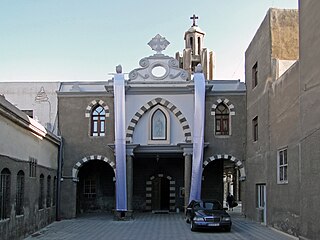
The Syriac Catholic Church is an Eastern Catholic Christian jurisdiction originating in the Levant that uses the West Syriac Rite liturgy and has many practices and rites in common with the Syriac Orthodox Church. Being one of the twenty-three Eastern Catholic Churches, the Syriac Catholic Church is a self-governed sui iuris particular church, while it is in full communion with the Holy See and with the entirety of the Roman Catholic Church.
Philoxenus of Mabbug, also known as Xenaias and Philoxenus of Hierapolis, was one of the most notable Syriac prose writers during the Byzantine period and a vehement champion of Miaphysitism.
Jacob of Edessa was Bishop of Edessa and prominent Syriac Christian writer in Classical Syriac language, also known as one of earliest Syriac grammarians. In various works, he treated theological, liturgical, canonical, philosophical and historical subjects, and contributed significantly to scholarly and literary development of Syriac Christianity. He is considered to be one of the most important scholars of the Christian-Aramean tradition.

Syriac literature is literature in the Syriac language. It is a tradition going back to the Late Antiquity. It is strongly associated with Syriac Christianity.

The West Syriac Rite, also called the Syro-Antiochian Rite and the West Syrian Rite, is an Eastern Christian liturgical rite that employs the Divine Liturgy of Saint James in the West Syriac dialect. It is practised in the Maronite Church, the Syriac Orthodox Church, the Syriac Catholic Church and various Malankara Churches of India. It is one of two main liturgical rites of Syriac Christianity, the other being the East Syriac Rite. It originated in the ancient Patriarchate of Antioch. It has more anaphoras than any other rite.
Athanasius II Baldoyo, also known as Athanasius of Balad, and Athanasius of Nisibis, was the Patriarch of Antioch and head of the Syriac Orthodox Church from 684 until his death in 687.
Saint Michael the Syrian ,(Classical Syriac: ܡܺܝܟ݂ܳܐܝܶܠ ܣܽܘܪܝܳܝܳܐ, romanized: Mīkhoʾēl Sūryoyo), died 1199 AD, also known as Michael the Great or Michael Syrus or Michael the Elder, to distinguish him from his nephew, was a patriarch and saint of the Syriac Orthodox Church from 1166 to 1199. He is best known today as the author of the largest medieval Chronicle, which he wrote in the Syriac language. Some other works and fragments written by him have also survived.
Qlisura was a diocese in the Syriac Orthodox metropolitan province of Melitene, attested between the ninth and thirteenth centuries. Eighteen Jacobite bishops of Qlisura are mentioned in the histories of Michael the Syrian and Bar Hebraeus, and in other West Syriac sources. By 1283, as a result of several decades of warfare and brigandage, the diocese of Qlisura was ruined, though it apparently still had a bishop several years later. The diocese is not again mentioned, and seems to have lapsed around the end of the thirteenth century.
Qlaudia was a diocese in the Syriac Orthodox metropolitan province of Melitene (Malatya), attested between the tenth and thirteenth centuries. Sixteen Jacobite bishops of Qlaudia are mentioned either by Michael the Syrian or Bar Hebraeus. By 1283, as a result of several decades of warfare and brigandage, the diocese of Qlaudia was ruined. The diocese is not again mentioned, and seems to have lapsed around the end of the thirteenth century.
Dülük is a neighbourhood in the municipality and district of Şehitkamil, Gaziantep Province, Turkey. Its population is 2,826 (2022). It is about 10 kilometres (6.2 mi) from Gaziantep city center. Its ancient name was Doliche.
Laqabin was a diocese of the Syriac Orthodox Church, suffragan of the archdiocese of Melitene. The diocese, also known as Qarna and Tella d'Arsenias, is attested between the tenth and thirteenth centuries. Twenty-three bishops of Laqabin are mentioned in the histories of Michael the Syrian and Bar Hebraeus and in other West Syriac sources. The last-known bishop of Laqabin, Timothy, was consecrated by the patriarch Philoxenus Nemrud (1283–92), and the diocese seems to have lapsed in the early decades of the fourteenth century.
Iwannis I was the Patriarch of Antioch and head of the Syriac Orthodox Church from 739/740 until his death in 754/755.
Athanasius IV Salhoyo was the Patriarch of Antioch and head of the Syriac Orthodox Church from 986/987 until his death in 1002/1003.
Ignatius II was the Patriarch of Antioch and head of the Syriac Orthodox Church from 878 until his death in 883.
Dionysius II was the Patriarch of Antioch and head of the Syriac Orthodox Church from 896/897 until his death in 908/909.
Athanasius VI bar Khamoro was the Patriarch of Antioch, and head of the Syriac Orthodox Church from 1091 until his death in 1129.
Julian II, also known as Julian the Roman or Julian the Soldier, was the Patriarch of Antioch and head of the Syriac Orthodox Church from 687 until his death in 708.
John XI bar Mawdyono, also known as Yuhanna Modyana, was the Patriarch of Antioch, and head of the Syriac Orthodox Church from 1130 until his death in 1137.
Athanasius VII bar Qatra was the Patriarch of Antioch, and head of the Syriac Orthodox Church from 1139 until his death in 1166.
Athanasius III was the Patriarch of Antioch and head of the Syriac Orthodox Church from 724 until his death in 739/740.



